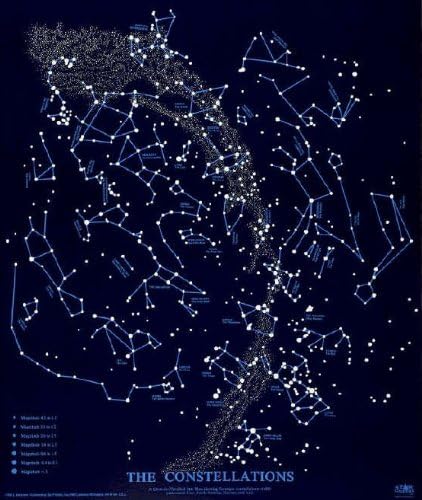Imagine the night sky to be a vast expanse dotted with stars, planets, and other celestial bodies. Astronomers rely on indispensable instruments called star charts to navigate this cosmic playground and uncover the mysteries of the universe. In this comprehensive guide, we will explore the intriguing world of star charts in astronomy, revealing how they function and how you can use them to explore the universe. Therefore, let’s embark together on this celestial voyage.
Contents
What Are Stellar Diagrams?
Star charts, also known as sky maps or celestial maps, depict the night sky graphically. They are indispensable for astronomers, stargazers, and amateur astronomers to identify and locate celestial objects. These schematics depict the relative positions of stars, constellations, planets, and other celestial bodies relative to the observer on Earth. Continue to learn how star charts function.
How do star maps function?
Star charts are similar to maps of the night sky, and comprehending how they function is essential for astronomy enthusiasts. Here’s how they operate:
Grid System: The lines on star charts depict celestial coordinates such as right ascension and declination. These grids aid astronomers in pinpointing specific celestial objects.
On a star chart, magnitude scale stars are frequently represented by marks or symbols. The magnitude of a star corresponds to the size and luminosity of these symbols; the smaller and dimmer the symbol, the fainter the star. This assists astronomers in determining the apparent luminosity of stars.
Constellation Lines: On star charts, lines connecting stars to form constellations are frequently depicted. These outlines facilitate the identification of familiar star patterns and constellations.
Planetary Paths: Star charts also depict the wandering paths of planets, as opposed to the fixed paths of stars. This enables astronomers to track the planets’ positions over time.
Star Chart Types There are numerous varieties of star charts designed for specific uses
Sky Maps for Novice Astronomers Simple sky maps are created for amateur astronomers. They highlight significant constellations and prominent stars visible to the naked eye, making them ideal for astronomy beginners.

Advanced astronomers frequently use specialized charts that are customized for specific telescopes and observing objectives. These schematics provide specific celestial object information for specific telescopes.
Numerous applications and software programs offer interactive, real-time star charts that you can use on your smartphone or computer in the digital age. These apps frequently include augmented reality features, making it simpler than ever to recognize stars and planets.
Utilizing Star Charts for Astronomy
Now that we comprehend what star charts are and how they function, let’s examine how to effectively utilize them for stargazing:
Select the Correct Chart: Select the appropriate star chart based on your equipment and level of experience. Beginning astronomers should begin with basic sky maps, while advanced astronomers may choose deep-sky or telescope-specific charts.
Choose Your Observation Location Star charts are dependent on location. Before leaving, ascertain the latitude and longitude of your observing location. This data ensures that your chart faithfully depicts the local sky.
Plan Your Observation Session To maximize your astronomy experience, plan your observation session in advance. Check the weather forecast, the phase of the moon, and the optimal periods to observe particular celestial objects.
Use Red Light: When using a star chart in the dark, use a red flashlight or red cellophane to conceal your regular flashlight. Red light preserves night vision, allowing you to read the chart without interfering with your ability to see the constellations.
To properly align your star chart with the night sky, hold it in front of you and align the cardinal directions (north, south, east, and west) with those in the actual sky.
Night Sky Exploration With your star chart
With your star chart in hand and your observation location chosen, it is time to explore the night sky. Here are some important celestial objects to observe:
Begin by identifying prominent constellations such as Orion, Ursa Major, and Cassiopeia. These are excellent points of reference for locating other celestial objects.
Check your star chart to determine whether or not any planets will be visible on the night of your observation. Through a telescope, planets such as Venus, Jupiter, and Saturn are readily identifiable and provide captivating views.
Deep-Sky Objects: To locate and observe galaxies, nebulae, and star clusters, use deep-sky charts. For a clear view of these objects, dark skies and telescopic aid are frequently required.
Along with constellations, you may encounter asterisms, which are minor star patterns within constellations. The Big Dipper, which is part of Ursa Major, is a notable example.
Observe your celestial chart for impending meteor showers. These celestial phenomena feature spectacular shooting star displays.
Superior Star Chart Methods
Consider the following advanced techniques if you wish to take your astronomy and use of star charts to the next level:
Star Hopping: Using brilliant stars as stepping stones to locate fainter celestial objects. It is a skillful method for discovering treasures in the deep sky that are not readily visible to the unaided eye.
Digital Star Chart Applications: Use digital star chart applications on your smartphone or tablet to observe celestial objects in real time. Numerous of these applications enable you to identify stars and planets through augmented reality when you point your device at the night sky.
Some astronomers appreciate sketching what they observe through their telescopes or recording their observations in a journal. Star charts can be indispensable for accurately documenting celestial observations.
If you own a telescope, you should consider using charts designed specifically for the field of view of your telescope. These schematics provide detailed information on the observable objects with your telescope.
The conclusion
In astronomy, star charts are indispensable instruments that facilitate the exploration of the universe. Understanding how to use these charts effectively can enhance your stargazing experiences, whether you are a neophyte or an experienced observer.
You will be well-equipped to navigate the night sky, discover celestial marvels, and increase your appreciation for the cosmos if you have the proper star chart.
Final Reflections:
When using star charts to explore the night sky, remember that patience and practice are essential. The universe contains an infinite number of undiscovered celestial marvels. So, grab your star chart, venture outdoors on a clear night, and allow the universe to reveal its secrets.
This concludes our astronomy guide to star charts. Please let me know if you have any specific queries or would like to explore any aspect of this topic in greater depth, and I will gladly provide additional information.


